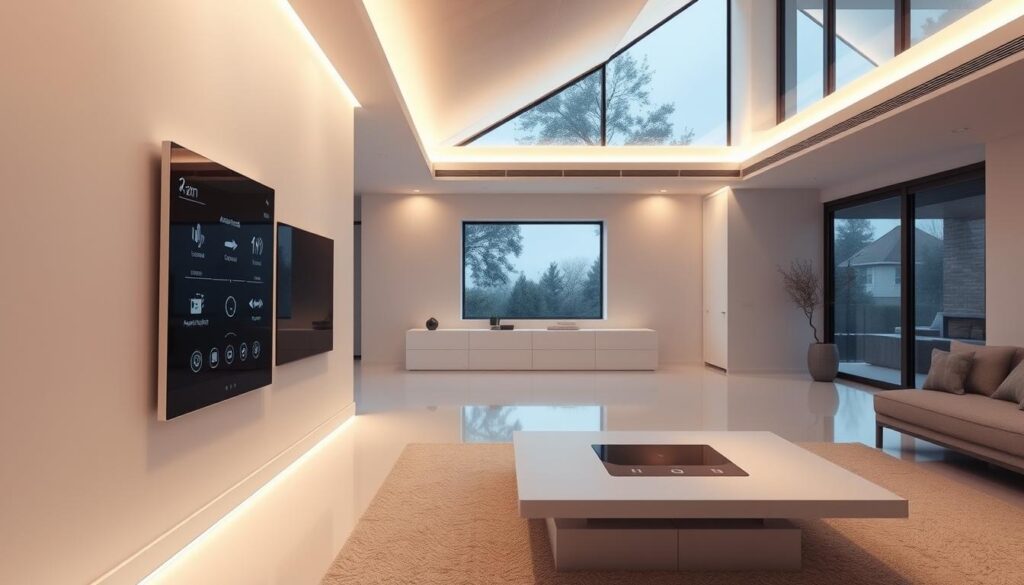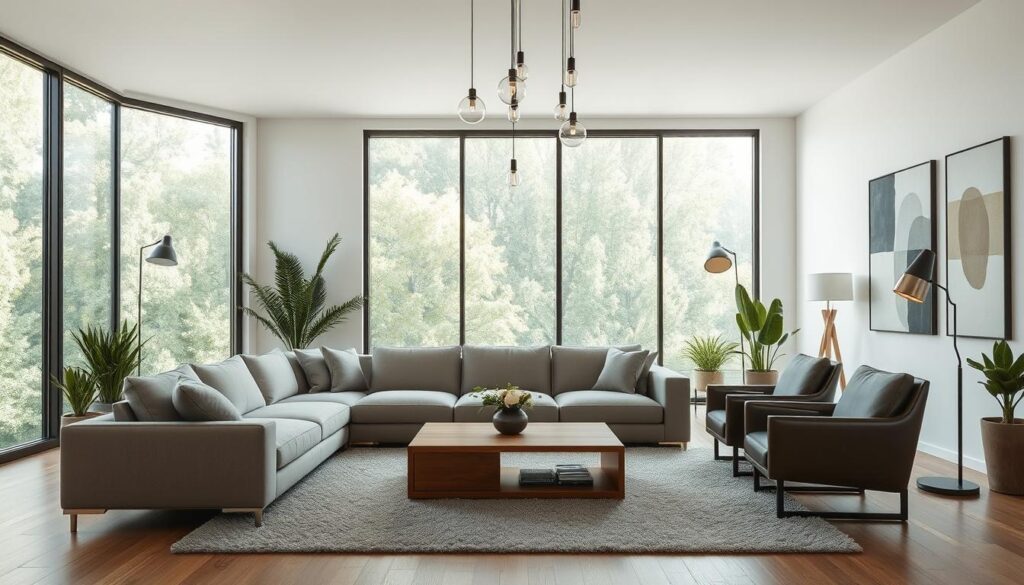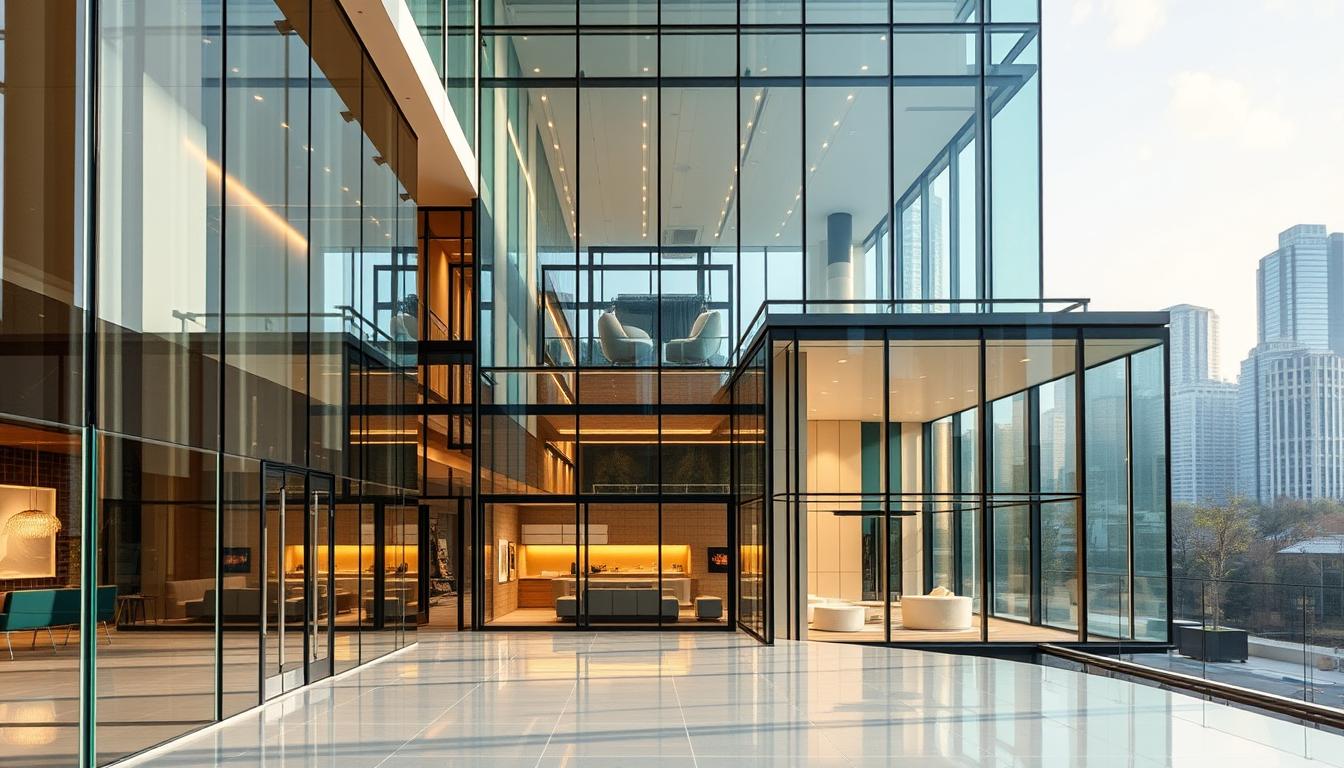Did you know that the way we design our living spaces can really affect our mood and how productive we are? As our lifestyles change, the need for a well-designed contemporary interior design has grown. Now, with more people living in cities, modern home design interior focuses on making spaces both useful and stylish.
We’ll dive into the world of modern home design. We’ll share tips and insights on making a space that’s both lovely and practical. By learning about modern design and staying up-to-date with trends, you can turn your home into a place that shows off your style.
Key Takeaways
- Understanding the principles of modern design
- Importance of functionality in interior design
- Incorporating the latest trends into your space
- Creating a stylish and functional living area
- Tips for transforming your living space
Understanding the Basics of Modern Home Design Interior
Exploring modern home design interior means learning its basics. It’s not just about looks; it’s about making a space that works well and feels good.
Modern design is all about simplicity. It uses clean lines, few decorations, and focuses on what works. This idea makes spaces both lovely and useful.
Key Characteristics of Modern Design
Modern design stands out with sleek home furnishings and a love for simplicity. Modern homes often have:
- Open floor plans that make rooms feel bigger and more connected.
- A mostly neutral color scheme, with bold touches here and there.
- Loads of natural light, thanks to big windows and skylights.
- Industrial materials like steel, concrete, and glass.
These features blend to create a minimalist home decor that’s both chic and practical.
Differences Between Modern and Contemporary Design
Modern and contemporary design are often mixed up, but they’re different. Modern design is a style from the early 20th century, known for its simplicity and usefulness. Contemporary design, though, is more flexible, showing off today’s trends and styles.
Contemporary design can mix many styles, from modern to traditional. It’s also shaped by new tech and materials. Knowing these differences helps homeowners choose the right design for their homes.
The Importance of Functionality in Our Spaces
Functionality is key in modern home design. It helps us live comfortably and efficiently in cities. Creating a chic interior layout that looks good and works well is essential.
To get this right, we need to optimize our living spaces. Space optimization techniques are vital in modern home design. They help us use every inch of space wisely.
Space Optimization Techniques
Effective space optimization requires careful planning and creativity. Using multi-functional furniture is a great way to do this. It helps reduce clutter and improves the flow of our homes.
Some important strategies include:
- Using wall-mounted shelves and storage units to make the most of vertical space.
- Choosing furniture with built-in storage to keep things tidy.
- Designing open floor plans to make our homes feel bigger.
Multi-Functional Furniture for Modern Homes
In urban home styling, multi-functional furniture is a big advantage. It keeps our homes looking chic while also being functional and comfortable.
Examples of multi-functional furniture include:
- Sofa beds that can be used for both sitting and as guest beds.
- Storage ottomans that offer a place to sit and store things.
- Extendable dining tables that can fit more guests when needed.
By using these items, we can make homes that are stylish and practical. They meet the needs of modern living.
Color Schemes that Enhance Modern Interiors
The right color scheme can change a modern interior’s feel. We’ll look at the latest trends and how colors affect us. This helps us pick a palette that looks great and shows our style.
Trending Color Palettes
Modern design loves many color schemes. From simple monochromes to bright mixes, there’s a lot to choose from. Neutral tones like white, gray, and beige are still in because they’re classy and easy to match. They let us add trendy home accessories that make a room unique.
Bold colors like emerald green, navy blue, and mustard yellow are also popular. Use them as accent walls or in furniture and decor. They add excitement and depth to any room.
The Psychology of Color in Home Design
Colors deeply affect our mood and actions. In design, knowing this can help us make spaces that feel right. For example, blue tones calm us down, making them great for bedrooms and bathrooms.
Warm colors like orange and red boost conversation and hunger. They’re perfect for dining and living areas. Choosing colors wisely can make our spaces more functional and peaceful.
Think about your home’s natural light when picking colors. It changes how colors look at different times. By matching colors with light, we create a welcoming and stylish space that shows off sophisticated design elements.
Choosing the Right Materials for a Modern Aesthetic
To get a modern look, pick materials that work well and look good. The right stuff can make your home look sleek and contemporary.
Sustainable Materials for Modern Design
We’re moving towards green materials in modern homes. They’re good for the planet and add character to your space. Bamboo flooring is a top pick because it’s tough and eco-friendly. Reclaimed wood brings warmth and history to modern rooms.
Recycled metal and glass are also great choices. They’re eco-friendly and add an industrial vibe. Using these materials helps us create stylish, green homes.
Textures to Consider
Material texture greatly affects your space’s look. Mixing textures adds depth and interest, typical of modern design. Try pairing smooth surfaces like marble or granite with rough ones like exposed brick or concrete.
Adding natural textures like wood or woven fibers brings warmth. The goal is to mix textures in a way that looks good and feels right.
Incorporating Natural Light into Our Designs
Adding natural light to our designs is more than just making a room look good. It also makes our living spaces healthier. Natural light makes rooms feel bigger and more welcoming. This is key when we aim for minimalist home decor that’s both useful and lovely.
To bring in natural light, we need to think about where we place our windows. The direction of windows affects how much sunlight they get. For example, south-facing windows get the most sunlight, perfect for living areas.
North-facing windows, on the other hand, offer softer, indirect light. This is great for rooms where direct sunlight isn’t wanted.
Window Placement Strategies
Choosing the right spot for windows is crucial. It depends on the room’s use and how much light you want. Kitchens and living rooms do well with big windows or sliding glass doors to let in lots of light.
Bedrooms, though, might need smaller windows or ones higher up to keep things private while still letting in some light.
For more tips on modern home design and balancing natural light with other elements, check out our detailed guide on modern home design interior.
The Role of Open Spaces
Open spaces are also important for letting natural light in. By removing walls and using open floor plans, we let light move more easily between rooms. This makes our homes feel bigger and reduces the need for artificial light during the day.
In short, using natural light in our designs means thinking carefully about where we put windows and how we use open spaces. This approach helps us create homes that are not just beautiful but also energy-efficient and healthy.
The Role of Technology in Modern Homes
Technology is changing how we live, and our homes are leading this change. We’re seeing homes become smarter, more efficient, and greener. This is thanks to new tech we’re adding to our homes.
Adding tech to our homes isn’t just about gadgets. It’s about making our lives easier and more enjoyable. Things like smart home systems and smart lights are making our homes work better for us.
Smart Home Integration
Smart home tech is getting popular fast. It lets us control our homes easily, from temperature to security. We can even use voice commands to manage it all.
- Enhanced convenience through centralized control
- Improved energy efficiency through automated systems
- Increased security with advanced monitoring systems
For example, smart thermostats learn our habits to save energy. Smart lights change color and brightness based on the time or activity.
“The future of home design is not just about aesthetics; it’s about creating a home that is intelligent, responsive, and adaptive to our needs.”
Innovative Lighting Solutions
Lighting is key in home design, and tech has brought new solutions. These are not only good for the planet but also let us customize our lighting.
| Lighting Type | Features | Benefits |
|---|---|---|
| Smart LED Lighting | Color changing, dimmable, programmable | Energy efficiency, customization, ambiance control |
| Automated Lighting Systems | Motion sensors, timers, remote control | Convenience, security, energy savings |
These lighting solutions can make any room feel more welcoming. They also help save energy, which is good for our wallets and the planet.

As we look to the future, tech in our homes will keep getting better. It will bring new ways to design and use our homes. By embracing these changes, we can make our homes beautiful, comfy, smart, and green.
Furniture Selection for Modern Home Design
Choosing the right furniture is key for a chic interior layout in modern homes. The furniture we pick shows our style and shapes our home’s look.
Modern furniture has clean lines, little decoration, and focuses on being useful. To get a unified look, knowing what makes modern furniture special is important.
Signature Modern Furniture Brands
Some brands are known for their modern furniture designs. These signature modern furniture brands include:
- Charles Eames: Known for their iconic designs that blend functionality with style.
- Eero Aarnio: Famous for his bold, ergonomic designs that have become staples in modern homes.
- Le Corbusier: A pioneer in modern architecture, his furniture designs are celebrated for their innovative use of materials and form.
These brands have greatly influenced modern furniture design. They offer stylish and useful pieces.
Creating a Cohesive Look
To get a cohesive look in your modern home, try these tips:
- Use a consistent color scheme that includes sophisticated design elements.
- Pick furniture that shares similar design traits, like clean lines or little decoration.
- Make sure scale and proportion are balanced for a harmonious feel.
By following these tips and choosing furniture from top modern brands, you can create a chic and sophisticated space that shows your style.
Decorative Elements that Compliment Modern Interiors
In today’s interior design, the right decor can really make a space feel like home. Decor isn’t just about color or texture. It’s about creating a look that shows off our style.
Art and Accessories for Modern Spaces
Choosing art and accessories for modern homes is all about balance. We need pieces that fit with our decor and add a personal touch.
“The key to great interior design is not just about filling the space, but about creating a narrative that resonates with the occupants.” This means picking art and accessories that tell a story or evoke feelings.

- Select art that resonates with your personal style.
- Use accessories to add texture and depth to your space.
- Consider the scale of your art and accessories in relation to the room.
Using Plants to Enhance Interior Design
Adding plants to our modern spaces is a smart move. They add interest and calm. Plus, they clean the air, which is great for city living.
When picking plants, think about the light, care, and look you want. For a minimalist vibe, sleek plants like succulents or air plants are good choices.
“The garden is a love song, a duet between a human being and Mother Nature.” – Jeff Cox
By adding art, accessories, and plants thoughtfully, we can make a modern space that’s beautiful and personal.
Creating a Seamless Indoor-Outdoor Connection
Making the indoors and outdoors blend together is key in sleek home furnishings and urban home styling. As we move forward in home design, linking indoor and outdoor spaces is vital.
To make this link, we can design patios and balconies that match our homes’ interiors. Using the same materials and colors inside and out helps create a smooth flow.
Designing Patios and Balconies
When planning patios and balconies, think about both looks and function. Pick furniture that’s comfy and can handle the weather.
- Choose outdoor furniture that mirrors the style of your indoor furniture.
- Use plants and greenery to bring a natural element into both spaces.
- Consider installing outdoor lighting that complements your indoor lighting fixtures.
This way, our outdoor spaces feel like part of our homes.
Benefits of Open Floor Plans
Open floor plans help link indoors and outdoors. By removing walls, we get a sense of openness and flow.
| Benefits | Description |
|---|---|
| Increased Natural Light | Open floor plans let natural light reach deeper into the home. |
| Improved Air Circulation | Without walls, air moves more freely. |
| Enhanced Social Interaction | Open layouts make it easier for family and guests to interact. |
As the table shows, open floor plans bring many benefits to our living spaces.
In summary, linking indoors and outdoors is a complex task. It involves designing patios and balconies and using open floor plans. This way, we get spaces that look good and work well.
Tips for Personalizing Modern Home Design
Making your home reflect your personality is key. In modern home design, this means adding elements that fit current trends and your style.
Balancing Trends with Personal Style
To get a chic interior layout, mix the latest trends with your style. Choose trendy home accessories that match your decor and keep your space fresh.
For example, pick trendy furniture or decor that shows your taste. This way, your home feels modern and personal.
DIY Ideas for a Unique Touch
DIY projects can give your home a unique flair. Think about repurposing old furniture or making your own decor, like throw pillows or wall art.
Some ideas include:
- Creating a gallery wall with personal photos or artwork
- Turning old furniture into new, useful pieces
- Making throw blankets or pillows with special fabrics
These DIY touches can make your chic interior layout stand out. It will not only look good but also share your story.
Adding trendy home accessories is another smart way to personalize your space. A standout piece of furniture or a set of decorative items can bring depth and character to your home.
Final Thoughts on Modern Home Design Interior
Creating a modern home that looks good and works well is all about careful planning. We’ve looked at how important function, colors, materials, and tech are. These elements help make a home that’s both beautiful and practical.
Emerging Trends
Future trends in home design will focus on being green and using space smartly. Things like smart tech and eco-friendly stuff will become more popular. This will help us make homes that are stunning and good for the planet.
Adapting to Change
Keeping up with design trends and being open to new ideas is key. By using modern design principles, we can make homes that are both trendy and useful. This way, our homes can grow with us, meeting our changing needs and tastes.


